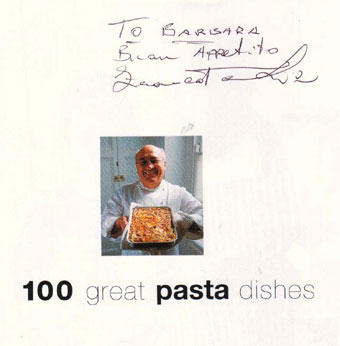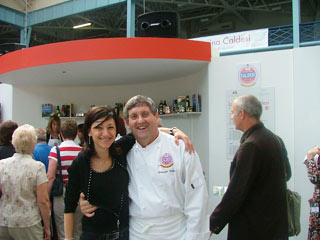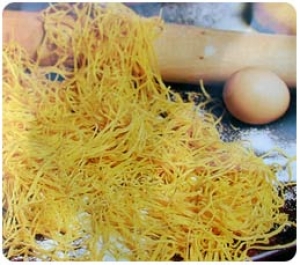The pot for cooking should be well capacious (at least 30/40 centimeters of diameter). It is advisable to use at least 1 liter or more of water for every 100g of pasta.
The use of a large and high pot ensures that the temperature of water remains constant. The addition of a tablespoon of olive oil to the cooking water, can help you to avoid pasta from sticking together.
Bring water to the boiling temperature and add salt (about 10g per 100g of pasta). Now wait few seconds until the salt is dissolved and the water starts boiling again.
It is a good idea to add the salt only when the water has reached full boiling temperature otherwise it will delay the boiling point.
 Pour the pasta only when the water restarts boiling, the flame must be at its maximum, so that the boiling restarts as soon as possible. Remember not to cover the pot. Moderate the heat as soon as the boiling restarts, taking care that the boiling is always constant and the pot not covered.
Pour the pasta only when the water restarts boiling, the flame must be at its maximum, so that the boiling restarts as soon as possible. Remember not to cover the pot. Moderate the heat as soon as the boiling restarts, taking care that the boiling is always constant and the pot not covered.
Stir the pasta gently with a fork when it is well soft, after half a minute for the smallest sizes (like Maccheroncini and Linguine) up to several minutes for larger sizes (like Tonnarelli and Chitarrine).
The cooking time is indicated on each pack but we suggest you to try it often to find the cooking degree that meets your personal taste. Break one noodle: if the center is still white, wait for a few minutes to finish cooking.
A tip: cook the pasta few seconds less, then drain carefully so that no residues of water remain. It is a good idea to keep a small quantity of cooking water to be added afterwards if the pasta appears too dry.
Once drained, pour pasta into a large tray, let it evaporate for a moment and add plenty of sauce since our pasta absorbs it a lot, mix gently and serve hot.
Some recipes state that the pasta ends its cooking in the pan with the sauce. In this case, we suggest that you drain the pasta one minute ahead and finish the cooking with the sauce.

THE EASIEST RECIPES:
- pasta with olive oil and grated Parmigiano Reggiano.
- pasta with sage leaves, lightly browned in a pot with butter, thin slices of Parmigiano
Reggiano optional.
- pasta with extra virgin olive oil, tomato pieces and fresh basil.
COOKING TIME:
Maccheroncini 1-2 minutes
Linguine 2-3 minutes
Fettuccine 2-3 minutes
Tagliatelle 3-4 minutes
Tonnarelli 5-6 minutes
Chitarra 8-10 minutes
Pappardelle 6-8 minutes
A guide for tasting egg pasta
Here follows some useful advice to taste egg pasta. An excellent pasta-as Antica Pasta is- should always satisfy even the most demanding client. In order to fully evaluate the egg pasta, the following steps involving all five senses should be kept in mind.
1-FIRST STEP-The Sight
The Colour: checking the colour of pasta is not superfluous, but instead an effective way to detect its quality. Pasta should have a light uniform colour, without irregular shadows. The colour should be amber yellow.
The Cooking Water: the better pasta quality is, the lower sediment quantity you will find in the water. In other words, when you drain the pasta, the cooking water should stay clear.
2- SECOND STEP- The touch
You should easily detect the difference between our pasta and a standard one, simply perceiving how irregular the surface is, first touching it by hand, then tasting it in your mouth.
3-THIRD STEP-The Hearing
If you want to be sure that egg pasta is good, try to break it before cooking it: it should break clearly.
4-FORTH STEP-The smell
When pasta is cooked, you can perceive the delicate smell of eggs and semola flour.
5-FIFTH STEP-The taste
Good food should be tasted as simple as possible! We invite you to taste our pasta before adding any sauce, to appreciate its delicacy and consistent taste at the best.
6-SIXTH SENSE-Different shape, different taste
In order to appreciate a good dish of pasta, the addition of some extra virgin olive oil and some parmigiano cheese is enough. Obviously, you can always try and enjoy new pasta shapes and sauces. Antica Pasta produces different pasta shapes. It's not only a matter of fantasy, but mainly a matter of taste. The taste changes according to pasta shape and sauce absorbing. In other words, the shape deeply influences the close relation between pasta and sauce, then different shapes correspond to different taste.
7- THE SEVENTH STEP- One-hour-after-cooking tasting
As the last tasting, eat our pasta, one hour after cooking it. Even if cold, you will notice that it is not sticky at all, but instead still "al dente", having completely absorbed the sauce.
COOKING TEST
At the end of the production process, our pasta passes through the cooking comparative tests. The cooking time, to keep pasta al dente without overcooking it, the eventual surface sticking, the sediment level in cooking water, the double cooking test for restaurant products are carefully checked and evaluated.





